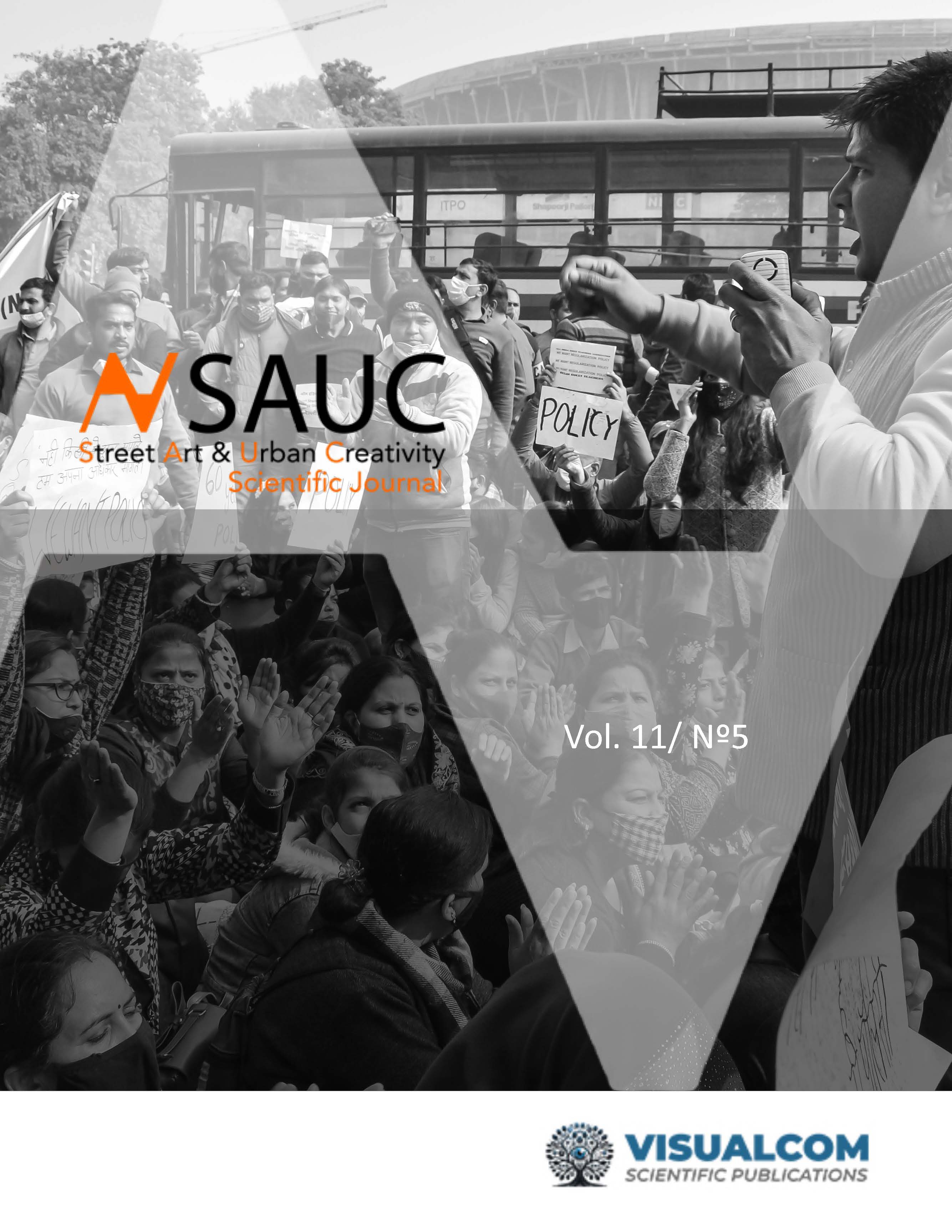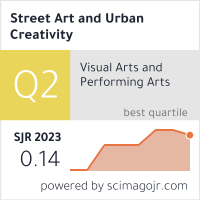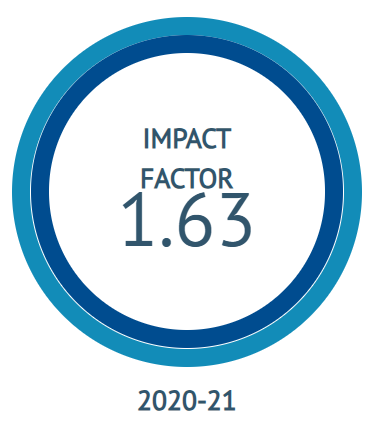Creativity as a transforming element of the territory
La Cárcel_ Segovia Creaction Center
DOI:
https://doi.org/10.62161/sauc.v11.5842Keywords:
Creativity, Territory, Cultural Industries, City, Communication, City Brand, City IdentityAbstract
This research addresses the transformative power of creativity in the construction of sociocultural and symbolic meanings. Using a qualitative, descriptive, analytical, and conclusive methodology, based on the analysis of multiple cases in combination with the analysis of a particular case, the study analyzes the re-signification of places associated with suffering, pain, and deprivation of liberty in antagonistic settings characterized by well-being, progress, and freedom.
A case study is carried out: “La Cárcel_Segovia Centro de Creación” (The Prison_Segovia Creation Center), which studies the reconfiguration of the former Provincial Prison of Segovia into a multidisciplinary space aimed at promoting artistic creation and socioeconomic development through the promotion of creative industries and the improvement of public space.
The results demonstrate the importance of creativity for the social, cultural, and economic development of territories.
Downloads
Global Statistics ℹ️
|
253
Views
|
236
Downloads
|
|
489
Total
|
|
References
Álvarez, F. J. L. (2017). Prisiones y presos políticos en España (1939-1975): repertorio bibliográfico. Cartas Diferentes: Revista Canaria de Patrimonio Documental, (13), 327-377.
Arquine. (2024). La transformación de una prisión a centro cultural [Fotografía]. Arquine. https://arquine.com/obra/rehabilitacion-de-la-antigua-prision-de-reus/
Ayuntamiento de Segovia. (2020). Galerías [Fotografía]. Segovia.es. https://segovia.es/portal/la-carcel/galerias
Ayuntamiento de Segovia. (2020). Microteatro [Fotografía]. Segovia.es. https://segovia.es/portal/la-carcel/microteatro
Ayuntamiento de Segovia. (2020). Encuentro Mujeres que transforman el mundo [Fotografía]. Segovia.es. https://segovia.es/actualidad/noticias/una-premio-nobel-de-la-paz-y-destacadas-activistas-de-diferentes-paises
Ayuntamiento de Segovia. (2024). Cartel Mujeres [Fotografía]. Segovia.es. https://segovia.es/actualidad/noticias/una-premio-nobel-de-la-paz-y-destacadas-activistas-de-diferentes-paises
Bartolomé, M. (1-3 de abril de 1992). La investigación participativa. Praxis. Ponencia presentada en las II Jornadas sobre la Logse. Perfiles para una nueva educación. Granada (p.24).
Bermejo, D. F. (2014). El fin constitucional de la reeducación y reinserción social: ¿un derecho fundamental o una orientación política hacia el legislador español? Anuario de derecho penal y ciencias penales, (1), 363-415.
Brandão, P. (2011). La imagen de la ciudad: estrategias de identidad y comunicación (Vol. 8). Edicions Universitat Barcelona.
Bravo, G. G. (2008). La política penitenciaria del franquismo en la consolidación del Nuevo Estado. Anuario de derecho penal y ciencias penales, 61(1), 165-198.
Cereghino-Fedrigo, A. M. (2024). Las conexiones interdisciplinarias en la investigación arquitectónica y urbana: un análisis de la Revista de Arquitectura (Bogotá). Revista de Arquitectura (Bogotá), 26(2), 1-22. https://doi.org/10.14718/RevArq.2024.26.6001 DOI: https://doi.org/10.14718/RevArq.2024.26.6001
Colmeiro, J. F. (2005). Memoria histórica e identidad cultural: de la postguerra a la postmodernidad (Vol. 40). Anthropos Editorial.
Conde, A. A., España, E. G., & Muñoz, J. B. (2012). Realidad y política penitenciarias. Boletín criminológico, (18). https://dx.doi.org/https://doi.org/10.24310/Boletin-criminologico.2012.v18i0.8037 DOI: https://doi.org/10.24310/Boletin-criminologico.2012.v18i0.8037
De las Heras González, M. G. (2019). La impunidad de la dictadura franquista: notas sobre la represión y la memoria histórica en la España democrática. Reflexión política, 21(43), 36-48. https://doi.org/10.29375/01240781.3707 DOI: https://doi.org/10.29375/01240781.3707
Erlason, D. A.; Harris, E. L.; Skipper, B. L., y Allen, S. D. (1993): Doing naturalistic inquiry, London: Sage.
Foucault, M. (1986). Vigilar y Castigar. Madrid: Siglo XX editores.
Gaggiotti, H. (2000). El espacio urbano como mediador de identidades. Espacio y territorio: miradas antropológicas, 5, 35.
García-Doménech, S. (2016). El espacio público como catalizador de la arquitectura, el arte y el diseño urbano. On the W@ terfront, 7-24.
Gennaro, G. (1975) Prision Architecture: An international survey of representative closed institutions and analysis of current trends in prision desing, Londres: The Architectural Press.
Hernández, A. (2023). La cárcel, de instrumento de castigo a bien cultural. Una aproximación a un ejemplo singular del patrimonio incómodo (No. ART-2023-139302).
Hugo Martín, C. (2023). Memorial [fotografía]. La Cárcel. Segovia Centro de Creación. Segovia. España. https://segovia.es/index.php/portal/la-carcel/memorial
Labanyi, J. (2006). Historias de víctimas: la memoria histórica y el testimonio en la España contemporánea. Iberoamericana (2001-), 6(24), 87-98. https://doi.org/10.18441/ibam.6.2006.24.87-98
Manso, C. (2023). Cárcel y ciudad: estrategias arquitectónicas de relación en la actualidad. Trabajo Fin de Grado / Proyecto Fin de Carrera, E.T.S. Arquitectura (UPM).
Merriam, S. B. (1998). Qualitative Research and Case Study Applications in Education. Revised and Expanded from «Case Study Research in Education». Jossey-Bass Publishers, 350 Sansome St, San Francisco, CA 94104.
Montero Pérez de Tudela, E. (2019). La reeducación y la reinserción social en prisión: El tratamiento en el medio penitenciario español. Revista De Estudios Socioeducativos. ReSed, (7), 227–249. https://revistas.uca.es/index.php/ReSed/article/view/4421 DOI: https://doi.org/10.25267/Rev_estud_socioeducativos.2019.i7.16
Narváez, N. S. (2015). Hacia la investigación multidisciplinar e interdisciplinar: reflexión sobre la aplicación de metodologías participativas y la investigación acción participativa en las ciencias sociales. Revista Humanismo y Cambio Social, 5, 74-82.
Ortiz García, C. (2012). Destrucción, construcción, reconstrucción, abandono: Patrimonio y castigo en la posguerra española. Hispania Nova: Revista de historia contemporánea, 10.
Rojo Álvarez, M. (2020). Las cárceles de Segovia: historia, ubicación y arquitectura. Trabajo Fin de Grado / Proyecto Fin de Carrera, E.T.S. Arquitectura (UPM).
Rodrigo, M. Y. (2014). El pasado como trauma: Historia, memoria y «recuperación de la memoria histórica» en la España actual. Pandora: revue d'études hispaniques, (12), 23-41.
Ruiz-Morales, M. L. (2020). La arquitectura penitenciaria como representación del castigo. Las maneras de comprender la pena de prisión en la historia. Política criminal, 15(29), 406-449. http://dx.doi.org/10.4067/S0718-33992020000100406 DOI: https://doi.org/10.4067/S0718-33992020000100406
Starkey, L. J. (1994). An evaluation of emergency food bags, Diet Association, 55, 175-178. https://agris.fao.org/agris-search/search.do?recordID=CA9502853
Torres, P. R. (2007). Los discursos de la memoria histórica en España. Hispania Nova: Revista de historia contemporánea, 7, 1-30.
Yin Robert K. (1984) Investigación sobre estudios de casos. Diseño y métodos. 2ª edición Sage Publicaciones.
Downloads
Published
How to Cite
Issue
Section
License
Copyright (c) 2025 Authors retain copyright and transfer to the journal the right of first publication and publishing rights

This work is licensed under a Creative Commons Attribution-NoDerivatives 4.0 International License.
Those authors who publish in this journal accept the following terms:
-
Authors retain copyright.
-
Authors transfer to the journal the right of first publication. The journal also owns the publishing rights.
-
All published contents are governed by an Attribution-NoDerivatives 4.0 International License.
Access the informative version and legal text of the license. By virtue of this, third parties are allowed to use what is published as long as they mention the authorship of the work and the first publication in this journal. If you transform the material, you may not distribute the modified work. -
Authors may make other independent and additional contractual arrangements for non-exclusive distribution of the version of the article published in this journal (e.g., inclusion in an institutional repository or publication in a book) as long as they clearly indicate that the work was first published in this journal.
- Authors are allowed and recommended to publish their work on the Internet (for example on institutional and personal websites), following the publication of, and referencing the journal, as this could lead to constructive exchanges and a more extensive and quick circulation of published works (see The Effect of Open Access).













